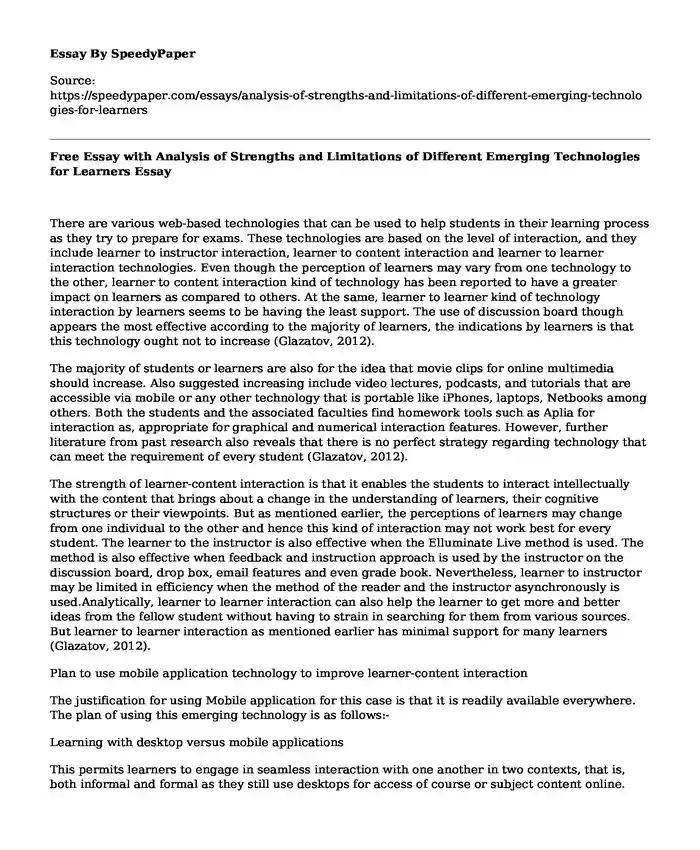
| Type of paper: | Essay |
| Categories: | Learning Education Technology |
| Pages: | 3 |
| Wordcount: | 801 words |
There are various web-based technologies that can be used to help students in their learning process as they try to prepare for exams. These technologies are based on the level of interaction, and they include learner to instructor interaction, learner to content interaction and learner to learner interaction technologies. Even though the perception of learners may vary from one technology to the other, learner to content interaction kind of technology has been reported to have a greater impact on learners as compared to others. At the same, learner to learner kind of technology interaction by learners seems to be having the least support. The use of discussion board though appears the most effective according to the majority of learners, the indications by learners is that this technology ought not to increase (Glazatov, 2012).
The majority of students or learners are also for the idea that movie clips for online multimedia should increase. Also suggested increasing include video lectures, podcasts, and tutorials that are accessible via mobile or any other technology that is portable like iPhones, laptops, Netbooks among others. Both the students and the associated faculties find homework tools such as Aplia for interaction as, appropriate for graphical and numerical interaction features. However, further literature from past research also reveals that there is no perfect strategy regarding technology that can meet the requirement of every student (Glazatov, 2012).
The strength of learner-content interaction is that it enables the students to interact intellectually with the content that brings about a change in the understanding of learners, their cognitive structures or their viewpoints. But as mentioned earlier, the perceptions of learners may change from one individual to the other and hence this kind of interaction may not work best for every student. The learner to the instructor is also effective when the Elluminate Live method is used. The method is also effective when feedback and instruction approach is used by the instructor on the discussion board, drop box, email features and even grade book. Nevertheless, learner to instructor may be limited in efficiency when the method of the reader and the instructor asynchronously is used.Analytically, learner to learner interaction can also help the learner to get more and better ideas from the fellow student without having to strain in searching for them from various sources. But learner to learner interaction as mentioned earlier has minimal support for many learners (Glazatov, 2012).
Plan to use mobile application technology to improve learner-content interaction
The justification for using Mobile application for this case is that it is readily available everywhere. The plan of using this emerging technology is as follows:-
Learning with desktop versus mobile applications
This permits learners to engage in seamless interaction with one another in two contexts, that is, both informal and formal as they still use desktops for access of course or subject content online.
Integrating mobile application technology in classroom for sustainability
Teachers to engage with the technology themselves before starting its implementation in practice within the classroom
Clear objectives of learning are to be set so that learners do not get preoccupied with the social media and by discovering techniques of employing social media in lesson plans. The use of mobile technology for activities of extension is also to be put into consideration.
In case the school does not have a policy of mobile learning, then at least one ought to be gotten before the start of the process.
Extra research has also been to be done concerning mobile application since it is not easy to know its suitability.
The class ought not to be overwhelmed by the mobile application technology given that learners frequently fail to discover the benefits of a given technology.
The application is to be used to make an introduction for activities of mobile learning each at a time after when learners and the teacher can reflect the usefulness of it as a group.
To help learners benefit for extra practice when they are back in the formal classroom, then as a teacher, you need to imagine how the technology can be employed in the informal learning that is outside classroom. This needs to be done in case there is no enough time in class to use mobile devices.
The teacher then needs to assess the understanding of learners through questions and answers.
Meeting the goal
The plan described above will help the student meet the goal of passing their exams successfully since mobile applications are flexible and portable hence each learner will be able to study and revise for exams via learner to content interaction irrespective of whether they are in class or not. This plan is represented using PowerPoint as shown in the attached presentation.
References
Glazatov, T, 2012 Applying Instructional Design System Theory to Mobile Learning Environments, Journal of Applied Learning Technology, 2 (2) pp, 29-35
Cite this page
Free Essay with Analysis of Strengths and Limitations of Different Emerging Technologies for Learners. (2019, Jun 26). Retrieved from https://speedypaper.net/essays/analysis-of-strengths-and-limitations-of-different-emerging-technologies-for-learners
Request Removal
If you are the original author of this essay and no longer wish to have it published on the SpeedyPaper website, please click below to request its removal:
- Essay Sample on Police Brutality and Racism
- A Moment Remembered - Personal Essay Sample
- Essay Sample Comprising the Nutrition Journal
- Free Essay Explaining the Difference between Social Work Leadership and Management
- Christianity Essay Example
- Essay Example American Censorship of Japanese Anime
- Free Essay: Training Leaders to Have Effective Leadership
Popular categories




